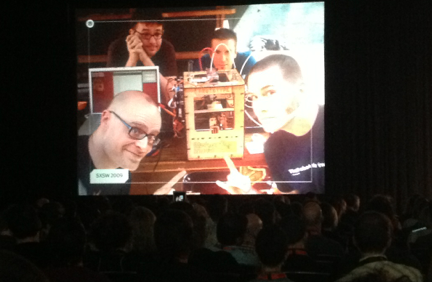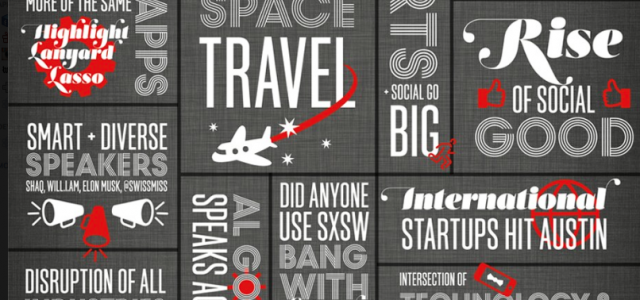I’m back from my second year at SXSW, and the experience feels like when runners go to train in a place like Denver so when they go back to their normal elevation they have unusual energy. This is where the richest people in the world and the smartest people in the world literally rub shoulders, and while the topic ranges from 3D printing to 4 hour chefs the thread is that technology is the coolest business to be in and that creating amazing user experiences is the highest form of art.
As with all conventions I can only relate the experiences I had and since there were many I missed #FOMO. I do think I chose a bit more wisely, and stayed a bit closer to the mothership, but still had one of m ybest experiences through serendipity. At the end of last year, I discovered the service www.storify.com which is a way to aggregate both your thoughts as well as the ones happening around you on different social media, especially twitter. These links go to raw notes.

Prototype, prototype, prototype
Bre Pettis, founder of Makerbot, started things up with merging the digital and physical world. Makerbots went from a circuit board and cardboard prototype to something now viable and somewhat cheap. The next step was to introduce a new product, this time, a plywood and laser-ready scanning machine. The theatricality and the feeling that we were seeing it made up as it was going along, and part of a game changing group was invigorating.

Gamification is still alive and well cwodtke
“The Mechanics of Magic” discussed how gaming and gamification techniques can be used to enhance and motivate the user. I’m fascinated about reward systems and think that designing positive feedback into every ‘serious’ interaction is long overdue. http://storify.com/michaeldain/mechanics-of-magic
Simple changes stick with BJ Fogg @bjfogg
Tiny Behavior, Little Steps for Big change. A behaviorist professor at Stanford I’ve been a fan for years, as BJ is trying to bring some new technology to human behavior. His technique involves finding the smallest, easiest positive behavior, and then attaching that new behavior to an existing one. For example. floss one tooth, and when you brush you add this habit of flossing one tooth. By keeping the pressure low, you have more chance to actually do it and see results. http://storify.com/michaeldain/tiny-behavior-little-steps-to-big-change
Getting UX into scrum and agile
@pieterj offered scrum tips (and agile methodology tips) at http://storify.com/michaeldain/get-agile
George Romero tells how they made Doom with George Romero
Great fun seeing the very nice George Romero give his breakdown of how iD software created Doom (it was started on a NExT computer in Madison WI! http://storify.com/michaeldain/george-romero-doom

The internet of things with Mickey McManus
The next talk was titled “Trillions” and had to do with ‘the internet of things’ and presented by Mickey McManus @mickeymcmanus. This was my highlight of the show. Mickey was responsible for the Pepsi note-sharing setup last year, which I wish I had paid more attention to. He wanted to communicate how to design this new world, where transistors are as plentiful, and cheap as grains of rice. It will take some new thinking about how layers of communication will have to be more like nature. The way DNA encodes. He also had the most amazing presentation, which I plan on stealing as soon as I figure out how they did it. http://storify.com/michaeldain/trillions
A robot in our pocket
Amit Kapoor and Jeff Bonforte discussed how the smartphone has become what we used to imagine as a ‘robot’, a device that tries to do our bidding. How did the smartphone get this lofty position? Because of the multitude of contexts it can provide to filter through all the data. Their companies, Gravity and Xobni try to make sense of all the clutter. This panel was a big hit, being both candid, funny, as well as putting a good spin on what makes mobile such a special beast.
Hype vs reality

Another dead on hit, the technology group from Digitas comes up with a novel visualization tool to discuss in real time what social data said about the proceedings, by navigating through summaries to individual hashtags, they painted a compelling if non-associative picture of what people were excited about. Apparently Elon Musk and Grumpy Cat won out. Who knew?
Power shift of media with Jonah Peretti
Jonah @peretti told the compelling story of Buzzfeed, and how people share stories not because of the stories, but because of the emotion they connote. The LOL, OMG tags of buzzfeed fit perfectly into brand expressions, who are now one of Buzzfeeds clients. A good wake up to agencies that sharing isn’t really an afterthought but baked deep into the content, and how google is perceived so much differently than facebook, or twitter. http://storify.com/michaeldain/power-shift-of-media

Moral Design by @rjowen
This was a great subject and talk on how when we design experiences, do we take into account the moral use or misuse of our application or service? Through many great examples, I took away that how we are treated by the systems we use really profoundly effects how we feel and act. When a company takes little effort in making experiences that communicate their values they not only risk irrelevance but they can also poison the culture, and the perception of the company by customers who will pick up on this indifference. This is so prevalent in large companies that I see huge opportunities in how this idea can be used in cementing the relationship between interfaces and the internal and external cultures.
Google Glass
And one of the most anticipated talks dealt with Google Glass. I’ll sum this up quickly, it was very well rehearsed, but also seemed to come from a deeply strange place, so you can tell that Google may get a bit myopic in some of their executions. Pun intended. I think couching this as a ‘place to start’ and a ‘micro-interaction platform’ was smart. There were also a nice JSON code base that dealt with the extremely minimal interface and transaction model. However the achilles heel was:
- You can’t wear glasses, and they don’t look like glasses, more like a ‘visor’ which is just too sci-fi, bluetooth headset looking.
- You can’t share things. Phones may get in the way, but they are visible and can be used to share things with others, glass is one-way and thus a bit too off-message.
- You use your voice or your finger to control it. This seems very awkward, especially the finger to the forehead Kreskin style fiddling about. This could be solved in future iterations but it just seems to serve how well phones fit our mental model of how things work, and these do not.
More than happy to revise this if I get a chance to use these, but the presentation had a feeling that Google sometimes misses out on how far they can stretch the envelope, and it makes for some odd PR for those who follow such things. It contrasts to Apple that always seems to take it for granted that people don’t really want technology, they just want a problem solved easily.
Cheers!
